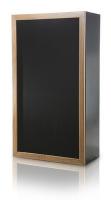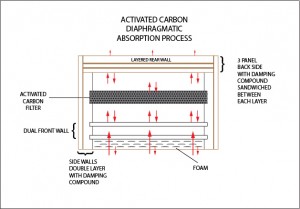Smaller Rooms / Low Frequency
In a lecture at Drexel University on acoustics, John Storyk of WSDG, the premier recording studio designer with offices across the globe, stated that the trend towards the future in the recording studio market is smaller rooms with creative low frequency management technologies to manage the room resonances that go with smaller room volumes. Low frequency management can take two basic forms. It can be active or passive. Active low frequency management is electronically based and passive technology involves the use of smaller, but more powerful traditional absorption which can be built into walls or freestanding.
Active Low Frequency Management
Active low frequency technology involves the use of noise cancellation technologies. Noise cancellation takes two signals that have equal amplitude and frequency and then focuses on their opposite polarity. When all of these variables are in line, we will have a complete cancellation of the chosen signal. This phenomenon is used when it comes to large amounts of industrial noise. Building barrier technology to isolate workers from this noise is expensive. Instead of shielding through barrier technology, we go the other way and amplify the signal. The problematic noise is then amplified and reproduced by speakers with inverted phase from the frequencies we wish to cancel. The result is greatly reduced sound pressure levels at the chosen low frequencies and the noise levels are reduced drastically without using cumbersome isolation technologies.
Passive Low Frequency Absorbers
Passive low frequency technologies can take two basic forms. One can use resonators or membrane absorbers. Resonating absorbers, such as the famed Helmholtz resonators, uses chambers of certain depths with slots cut into the top of the chamber to let the air in. It is the air inside the chamber that resonates at a certain frequency depending on the chamber’s designed volume and area of the opening. All frequencies above the chamber’s resonate frequency are absorbed. Frequencies below the chamber’s resonating frequency are not.
Membrane Absorbers
Membrane absorbers have a membrane or wall that vibrates when sound pressure energy strikes it. The front wall membrane is surrounded by a cabinet that is rigid and has a certain type of cabinet fill to absorb internal cabinet resonances. The vibrating membrane slows the sound energy down and then it enters the inside cabinet fill material and is reduced in intensity. Some of the energy is absorbed, some is sent back through the front wall membrane, and some leaves through the rear of the cabinet. The sum of all of these variables determines the cabinet’s total absorption performance.
Diaphragmatic Absorbers
Membrane absorbers are also termed diaphragmatic absorbers. The front wall or membrane acts like a piston and vibrates in sympathy to the sound pressure exerted upon it. This front wall movement is said to be diaphragmatic because of this movement. The diaphragm movement is not visible movement like a speaker. It is microscopic movement that the sound pressure exerted upon it produces. This moving of the diaphragm, slows the sound energy down before it enters the inside of the cabinet.
Diaphragmatic Absorber Improvements
To maximize this movement/absorption process in a diaphragmatic absorber, we can do three major improvements to this time tested and proven technology in order to improve its overall performance. We can add an additional front wall or diaphragm, use a more sound absorbing internal cabinet fill, and make the cabinet more rigid to force the dual front wall diaphragms to move more to increase rate of absorption.
Two Front Walls
When we add an additional front wall, our design goal is to get both walls working together to maximize efficiency in slowing down the energy that strikes them before it enters the inside of our absorber. This sympathetic movement is based on the density of each wall which must be different and the distance between each wall. Vibrational analysis of each wall will assist one in determining the appropriate wall density to be used and the air space required between them to produce maximum efficiency.
Internal Cabinet Fill
The internal cabinet fill with our new, dual wall, diaphragmatic absorber has traditionally been a type of building insulation. Fiberglass and mineral types have been commonly used. In fact, the interior walls of most rooms can be considered a diaphragmatic absorber but with limited low frequency attenuation. The cabinet is the drywall on each side of the wall and the insulation between the studs is the internal cabinet fill. To absorb more energy, the internal cabinet fill can be activated carbon or charcoal. Charcoal has numerous pores that absorb sound energy and each charcoal pellet has thousands of pores. Sound energy enters each pore and is absorbed. This large amount of pore absorption, lowers the cabinet’s internal Q value to a level never before achieved in the scientific literature.
Multiple Layered Cabinet
The cabinet construction must work together with the dual front wall construction. We want to encourage the dual front walls to move without the cabinet moving. The cabinet must be designed to be as inert as possible, similar to a speaker cabinet. One can achieve this cabinet rigidity by using multiple layers of materials that have different densities with each layer separated with vibrational damping compound. The key to the process of making the cabinet as inert as possible is to choose cabinet layers that have the correct densities that when married together, the vibrational energy transmission is reduced from layer to layer throughout the cabinet.
Smaller Rooms Require More Creative Approaches
Smaller room volumes in today’s recording studios produce larger low frequency resonances. This requires the need for either active or more powerful passive absorption technologies. Active noise cancellation technologies require an electronic approach where a signal is interjected into the room through a speaker. The energy interjected into the room is out of phase with the frequency that is chosen to be absorbed and this active process results in frequency cancellation and reduced sound pressure levels. Existing passive, low frequency, technologies can be improved upon by fortifying existing design criteria.








The discussion on ductwork noise transmission from Acoustic Fields highlights crucial aspects of HVAC system acoustics. The movement of air…
Great build plans. thank you Denis
You must use absorption. Never place a chair against a wall.
A friend and I built several diffusors using these plans and they turned out absolutely beautiful. Very good instructions and…